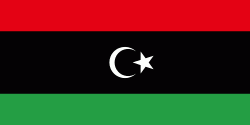Jafara (Al Jafārah)
Jafara or Al Jfara (الجفارة Al Jifārah) is one of the districts of Libya, in the historical region of Tripolitania. Its capital and largest city is 'Aziziya. Jafara borders Tripoli in northeast, Jabal al Gharbi in south and Zawiya in the west.
From 2001 to 2007, Jafara District consisted of twenty Basic People's Congresses (BPCs). In 2007 it was enlarged by the addition of four BPCs from Tarabulus District (Tripoli), and presently consists of twenty-four Basic People's Congresses.
Per the census of 2012, the total population in the region was 157,747, with 150,353 Libyans. The average size of the household in the country was 6.9, while the average household size of non-Libyans being 3.7. There were totally 22,713 households in the district, with 20,907 Libyan ones. The population density of the district was 1.86 persons per km2. Per 2006 census, there were totally 163,882 economically active people in the district.
Libya has mostly a flat undulating plain and occasional plateau, with an average elevation of around 423 m. Around 91 per cent of the land is covered by desert, with only 8.8 per cent agricultural land (with only 1% arable lands) and 0.1 per cent of forests. The major resources are petroleum, gypsum and natural gas. Along the coastal regions, the climate is Mediterranean in coastal areas, while it is desert climate in all other parts. Dust storms lasting four to eight days is pretty common during Spring. Triplotania is the northwest region, while it is Cyrenacia in the east and Fezzen in southwest. Triplotania runs from north to south and has set of coastal oases, plains and limestone plateaus having an elevation of 2000 ft to 3000 ft. The region receives an annual rainfall of 16 in. There are no perennial rivers in the region, but the region is abundant with groundwater aquifers. Most of the major cities of Libya are located in the coastal regions.
From 2001 to 2007, Jafara District consisted of twenty Basic People's Congresses (BPCs). In 2007 it was enlarged by the addition of four BPCs from Tarabulus District (Tripoli), and presently consists of twenty-four Basic People's Congresses.
Per the census of 2012, the total population in the region was 157,747, with 150,353 Libyans. The average size of the household in the country was 6.9, while the average household size of non-Libyans being 3.7. There were totally 22,713 households in the district, with 20,907 Libyan ones. The population density of the district was 1.86 persons per km2. Per 2006 census, there were totally 163,882 economically active people in the district.
Libya has mostly a flat undulating plain and occasional plateau, with an average elevation of around 423 m. Around 91 per cent of the land is covered by desert, with only 8.8 per cent agricultural land (with only 1% arable lands) and 0.1 per cent of forests. The major resources are petroleum, gypsum and natural gas. Along the coastal regions, the climate is Mediterranean in coastal areas, while it is desert climate in all other parts. Dust storms lasting four to eight days is pretty common during Spring. Triplotania is the northwest region, while it is Cyrenacia in the east and Fezzen in southwest. Triplotania runs from north to south and has set of coastal oases, plains and limestone plateaus having an elevation of 2000 ft to 3000 ft. The region receives an annual rainfall of 16 in. There are no perennial rivers in the region, but the region is abundant with groundwater aquifers. Most of the major cities of Libya are located in the coastal regions.
Map - Jafara (Al Jafārah)
Map
Country - Libya
 |
 |
| Flag of Libya | |
Libya has been inhabited by Berbers since the late Bronze Age as descendants from Iberomaurusian and Capsian cultures. In classical antiquity, the Phoenicians established city-states and trading posts in western Libya, while several Greek cities were established in the East. Parts of Libya were variously ruled by Carthaginians, Persians, and Greeks before the entire region becoming a part of the Roman Empire. Libya was an early center of Christianity. After the fall of the Western Roman Empire, the area of Libya was mostly occupied by the Vandals until the 7th century when invasions brought Islam to the region. In the 16th century, the Spanish Empire and the Knights of St John occupied Tripoli until Ottoman rule began in 1551. Libya was involved in the Barbary Wars of the 18th and 19th centuries. Ottoman rule continued until the Italo-Turkish War, which resulted in the Italian occupation of Libya and the establishment of two colonies, Italian Tripolitania and Italian Cyrenaica (1911–1934), later unified in the Italian Libya colony from 1934 to 1943.
Currency / Language
| ISO | Currency | Symbol | Significant figures |
|---|---|---|---|
| LYD | Libyan dinar | لد | 3 |
| ISO | Language |
|---|---|
| AR | Arabic language |
| EN | English language |
| IT | Italian language |















